Mountain pine "Mugus" in landscape design. Fruit garden in landscape design - the perfect solution for a small area
The question of which trees to choose for landscape design is decided in each specific case taking into account many factors. Not only the design solution of the site design project is taken into account. Environmental conditions are taken into account - proximity highways, buildings and other points.
A thoughtful selection of trees and shrubs helps to solve a complex problem, the ultimate goal of which is to provide the site with an attractive view not only in summer, but throughout the year.
Basic principles of tree selection
The main rule to follow when choosing trees is how suitable they are for harmonious participation in solving the problem of the general. The selection criterion should not only be attractive appearance tree, but also how it meets the necessary requirements:
- Reasonable ratio with the size of the site. A plant that can grow to gigantic sizes - oak or chestnut - will look somewhat awkward in a small area, besides, the powerful roots of such a tree will deprive nutrients other nearby plants.
- Illumination or shading of the intended landing site. Planting a sun-loving breed in a poorly lit area will lead to the fact that, if it survives, it will have
not at all the presentable appearance that was expected from him. - Tolerance for soil quality. If the quality of the soil, especially its acidity, is not suitable for the selected breed, the plant will lose its decorative qualities. The situation will not become so critical if the soil is saturated with special additives and high-quality drainage is ensured.
- Compatibility of the tree in terms of foliage color and crown shape with other elements of the landscape.
- Peculiarities natural conditions. Many coniferous trees do not tolerate hot climate conditions, and southern fruit trees, planted much to the north, give only foliage, but do not bloom and do not bear fruit.
It is important to consider that the more decorative a plant has, the more difficult it is to adapt to changing conditions, especially if they differ from the optimal ones for it. fruit trees in landscape design are used most often to create original alleys or to emphasize a certain fragment of the overall picture.
Experts advise choosing different types and species, avoiding planting a site with homogeneous trees. Then, with the invasion of pests or specific diseases, there is a chance to get off with the loss of only one tree, and the rest will remain healthy.

At deciduous trees the main skeletal axis is well expressed, the crown is formed by a bunch of large leaves, side branches and shoots. A complex impression is produced by the shape, color of foliage, and the smell of flowers.
- Bloom. This is the main decorative feature. Large beautiful flowers are distinguished by magnolia and sakura, in most trees the flowers are small, often inconspicuous (maple, willow). Some have abundant beautiful, but short flowering (acacia, bird cherry, chestnut).
- Aroma. It usually gets worse in the evening or at night. Of the especially fragrant, acacia, bird cherry, linden are distinguished.
- Bloom time. Dogwood, hazel, and some types of willow bloom earlier than others.
- Decorative fruits. This sign is not a priority, but deserves attention - mountain ash or viburnum are very attractive when bright scarlet clusters remain on the branches freed from foliage.
- Leaves. The main indicator in relation to landscape design. The focus is on color, shape, color change in the autumn.
- Crown shape. It comes in different shapes - triangular, rounded, pyramidal, weeping, columnar. Linden, oak and maple differ in irregular shape.
Rules for planting deciduous trees:
- The choice of location is carried out with a reference to the size that an adult plant will reach. The distance between the trees should be about half their height. This rule does not apply to hedges and columnar trees.
- Container-grown seedlings can be planted at almost any time of the year, but for deciduous species, it is best to do this in autumn or spring. Seedlings with an open root system are planted in autumn.
- A pit for planting in size should be prepared twice the size of the root ball. In swampy or heavy soils, drainage is necessarily laid on the bottom. Fill the hole with fertile soil, compact it a little and water it abundantly.
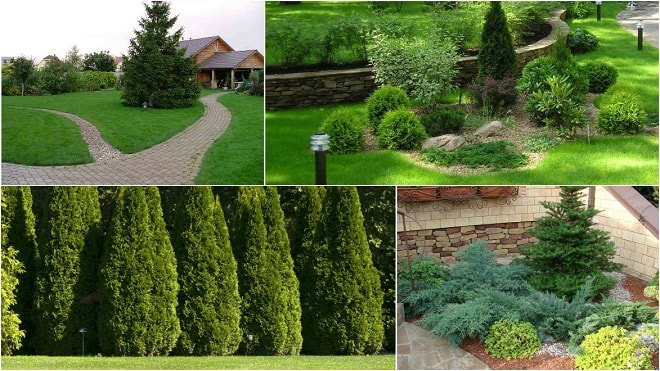
When selecting coniferous trees, one should take into account, first of all, climatic stability and be guided by the recommendations offered by experts:
- Crown shape. Some conifers have a spherical shape, formed by branches of equal length. With geometrically correct forms of crowns, conifers can be planted to give the landscape solemnity or severity. Popular weeping conifers - Nutkan cypress and European larch - are planted where an emphasis is needed on the lower part of the landscape: near water bodies and in flower beds.
- Phytoncidal properties. Some conifers produce essential oils, the intensity of the secretions of which depends on the growing conditions and the time of year. Larch is especially fragrant in spring, and in summer it practically has no smell, but pine in the summer heat gives a strong resinous aroma.
- Bark. Coniferous bark can bring a special flavor to the landscape pattern.
- Cones. In pines, they hang from branches, they are up to 25 cm long. At fir, they are directed upwards, creating the impression of spaced candles. The cones of a young spruce are distinguished by a bright purple or reddish color.
- Needles. The color palette of conifers is all shades of green, sometimes blue, golden, yellow and white needles. Cypress and fir with silver-blue needles are very popular. They are followed by golden-yellow Lavson cypress and pea-bearing, western and folded thuja.
- Growing conditions. The popularity of using conifers in landscape design decisions comes from their relative undemanding to growing conditions.
Conifers can be selected for almost any type of soil and lighting conditions: for light and dry sandy soil - junipers and pines, for areas with high humidity - swamp cypresses, for shaded - yew.
Rules for planting coniferous trees:
- Most often, coniferous trees from nurseries are sold in pots - with a closed root system. Such material is suitable for planting at almost any time of the year.
- A landing pit is prepared twice as large as a pot. The pot is placed entirely in a container of water so that the root ball is well saturated with moisture.
- The root ball is freed from the pot. A strongly intertwined root system is slightly thinned out and loosened. It must be remembered that conifers cannot be planted buried in the soil. After planting, water the ground around the tree.
- Stem circles of conifers are mulched with compost, mowed grass or chopped bark.
- Trunk circles need to be loosened regularly. Trees need watering and feeding. Pruning coniferous trees is reduced only to the removal of diseased and withered branches.
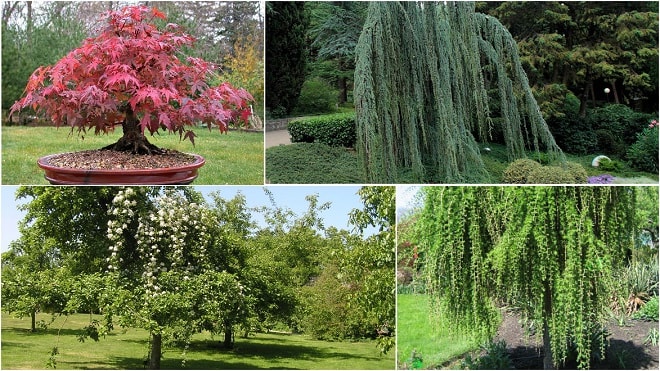
A very original picture of the landscape can be created using trees grafted on a trunk for planting. Such a plant is a smooth bare trunk with a spherical cap of a deciduous crown. This special form is created by grafting a weeping, spherical or curly crown onto an even trunk. The same effect can be achieved by cutting trees of certain species. The standard type of trees is up to 5 meters high, but trees up to 2.5 m are usually used in landscape design. This can also be solved Orchard and a recreation area.
Blooming standard roses and viburnum look amazing. In winter, the standard type has an equally spectacular appearance of a spherical dome of winding branches covered with fluffy snow.
- Standard trees are compact and miniature, they save the space of the site.
- Spherical shapes are not a curiosity, but maples, ash trees, acacias, willows, arborvitae and larches do not lose their popularity.
For grafting on a trunk, plants of the same botanical genus are used. A rose is grafted onto a wild rose, a weeping elm onto a rough elm, a weeping willow pear onto a domestic pear. Sometimes similar plants are grafted - pear on mountain ash, shadberry or cedar on pine.
The grafted plant begins to bear fruit much earlier than the usual one. But the life span of the stem is much lower, and there is always a high risk that the grafting site will break from a strong wind.
Obtaining a standard form using pruning takes time - year after year, all side shoots are cut to a certain height.
Features of the location of trees on the site
Trees for landscape design are selected taking into account exactly how each plant will be located in the overall project. Trees are arranged in several ways - in groups, as part of an alley, singly or in a hedge.
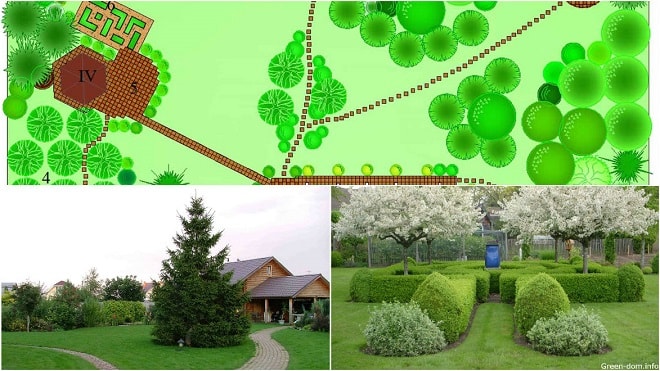
Ordinary - single planting
Standing alone, a single plant should be ideal throughout the season, as it is to it that the eye is drawn. On small area it is possible to land only one ordinary, so its shape is thought out very carefully, taking into account all possible nuances.
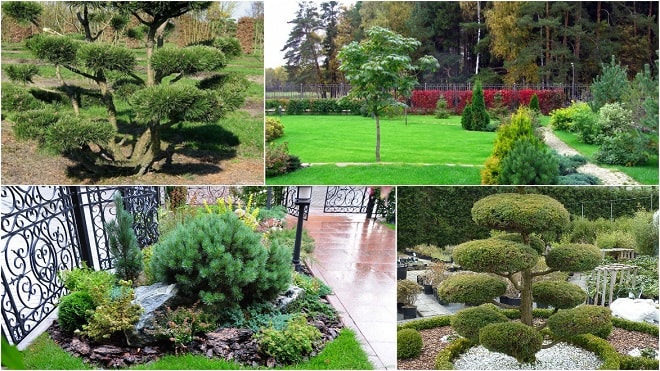
Groups - planting plant compositions
This is the planting of several trees in the form of a certain compositional solution. Usually plants are planted in a group different types to make it easier to obtain the principle of tiering. Large trees are planted in the background, tall shrubs in front of them, and stunted ones in the foreground. Different colors of foliage and bright flowers can give the group contrast and brightness, while each such composition will be distinguished by its unique originality.

- If the group is planted in the center of the site, then the tallest trees are located in its middle. When placing a group against the wall of a building or fence, the tallest plants are planted closer to the wall.
Plants in a group should not shade each other; when planting them, it is recommended to maintain the necessary distances between trees and shrubs.
Planting hedges
Usually a hedge is a very dense planting of shrubs. Sometimes they create hedges from trees. Hedges can serve as a fence of the site or perform the task of zoning the territory within it.
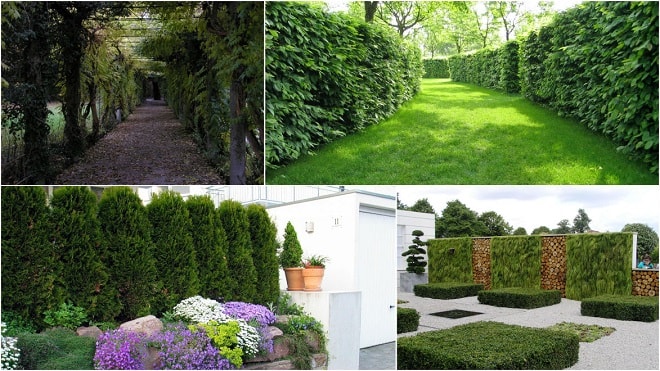
- For low, up to 2 m, hedges, an excellent candidate is edible honeysuckle. With the proximity of the road, protection from dust and smog will be better than others provided by irga or viburnum. Irga does not grow and does not require thinning. Gooseberries and currants are suitable for dense hedges, reaching 1.5 m in height.
Large trees are not suitable for forming a low border, and low bushes are not suitable for creating a living wall. In addition to this principle of choosing material for a hedge, it is important to consider the size of the leaves - large-leaved specimens are inappropriate for this purpose. All selected plants must be winter-hardy, because if one of them freezes, replacing it inside an already formed hedge will be very problematic.
Planting plants in the form of alleys

Alleys are paths lined with trees or shrubs on each side in compliance with a certain planting rhythm. In the alleys, close planting of trees is allowed, which form a closed vault with crowns. The landing of alleys implies the presence of a large free area in the adjacent space. For a small personal plot, this form is not practical: instead of giving the landscape a harmonious perfection, it can create a feeling of chaotic clutter.
Not every tree is suitable for a literate. Landscape design is not only an art, but also a complex of knowledge from different scientific fields.
Trees in the country or in the garden are perennial plants, many of them grow for more than one decade. That is why the choice of certain specific tree species should be made by the one who lives among them - the owner of the site. Specialists - landscape designers and dendrologists - can and should provide him with the necessary information and recommendations. A variety of fruit and ornamental trees allows you to make the best choice for almost any site where landscape design is carried out.
Coniferous trees and shrubs are in great demand in landscape gardening, their photos can be increasingly found in magazines and sites dedicated to landscape design. They are frost-resistant, decorative, hardy, unpretentious in care and are distinguished by a variety of crown shapes.
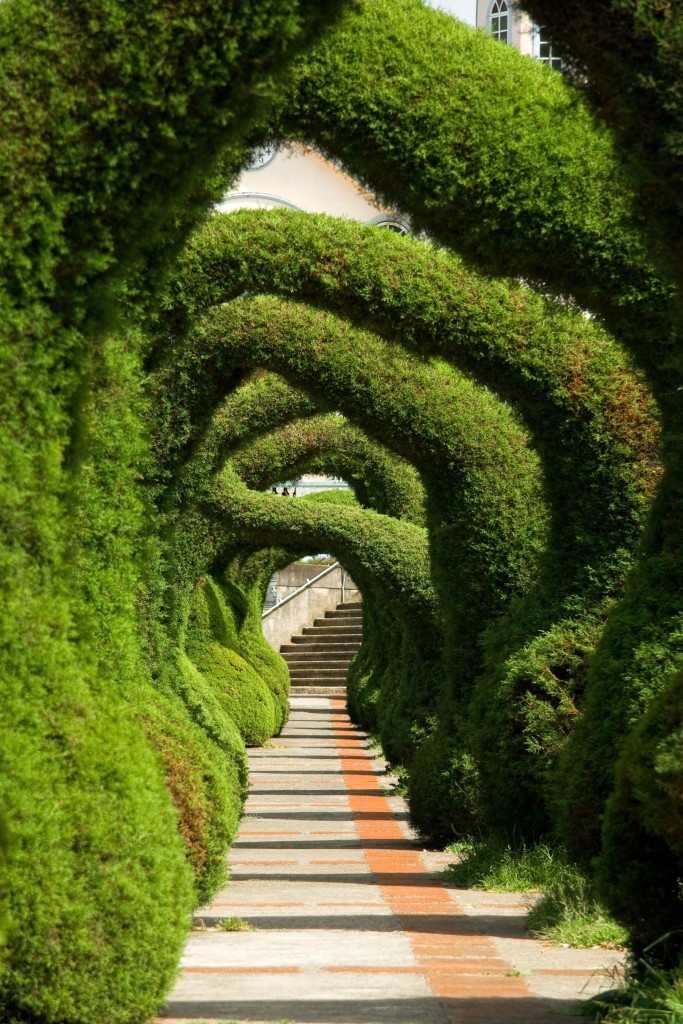
Gardeners love coniferous plants and for their many other virtues:
- many varieties of conifers tolerate limited sunlight well, develop well in partial shade
- the well-developed root system of conifers allows them to tolerate well for a long time without watering, some types of plants grow well on stony soils. In addition, due to powerful and developed roots, they can be used to strengthen the slopes.

- most conifers tolerate shearing well, they (some varieties of thuja look especially attractive in this regard) can be used to obtain a variety of figures that are often found in photos of regular English gardens. And some varieties of conifers by nature have a geometrically correct shape, so they practically do not need care.
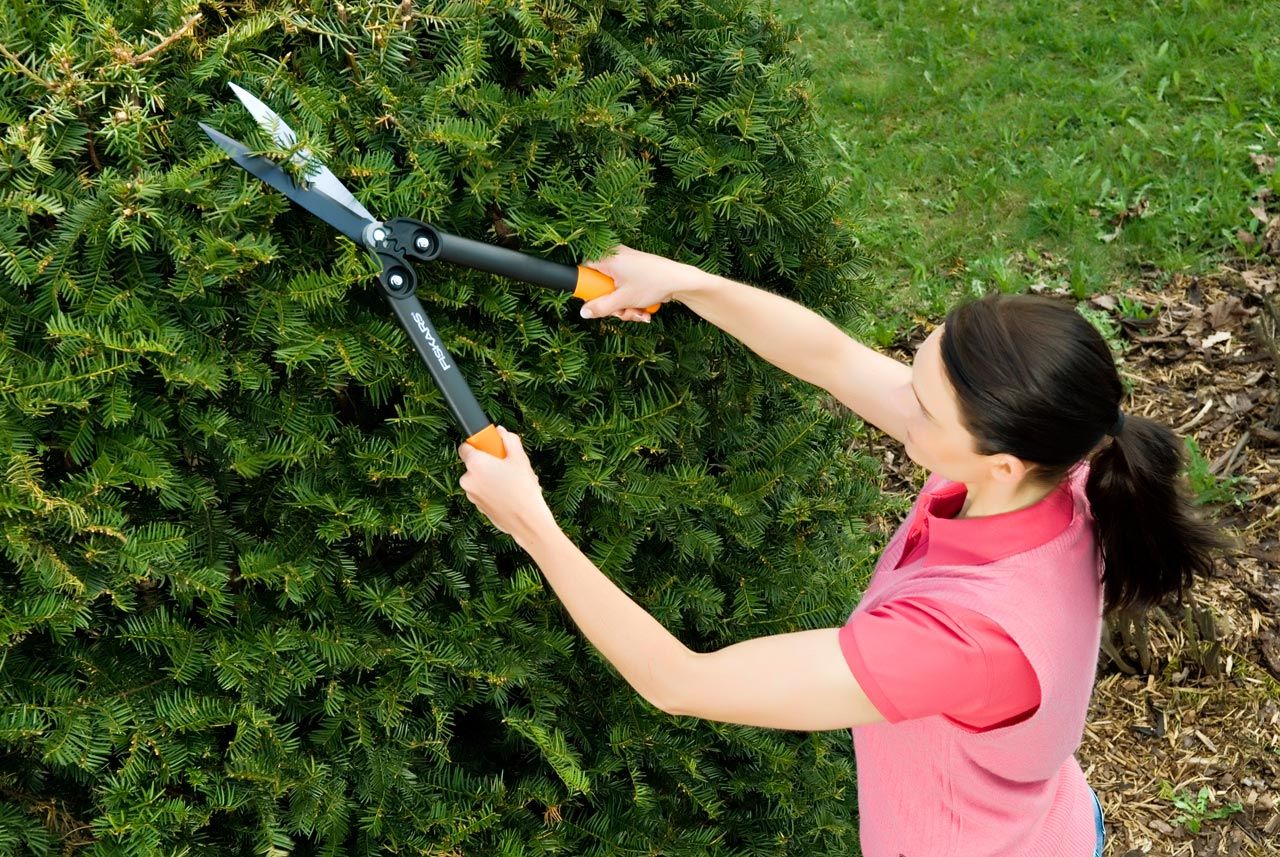
- coniferous tree - a source of useful phytoncides, a walk in the garden with coniferous plantings has a beneficial effect on both the physical and psychological state of a person
- conifers perfectly tolerate a smoky urban environment
- maturing cones will attract birds to the garden, filling it with life and movement
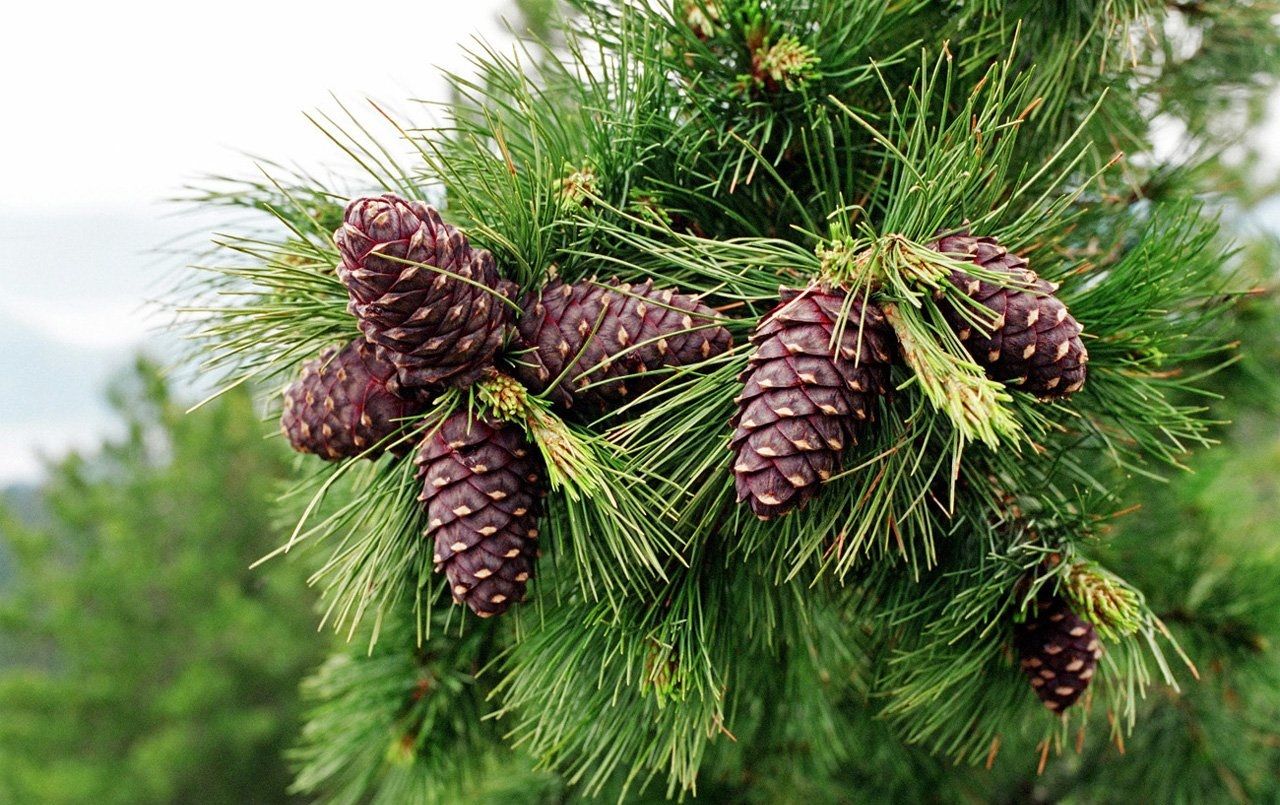
But the main thing that attracts conifers and shrubs, for which they are “loved by design” - with their green color they bring variety and liveliness even to a gloomy, gray and gloomy autumn-winter garden.
Coniferous plants: how to place in the garden correctly
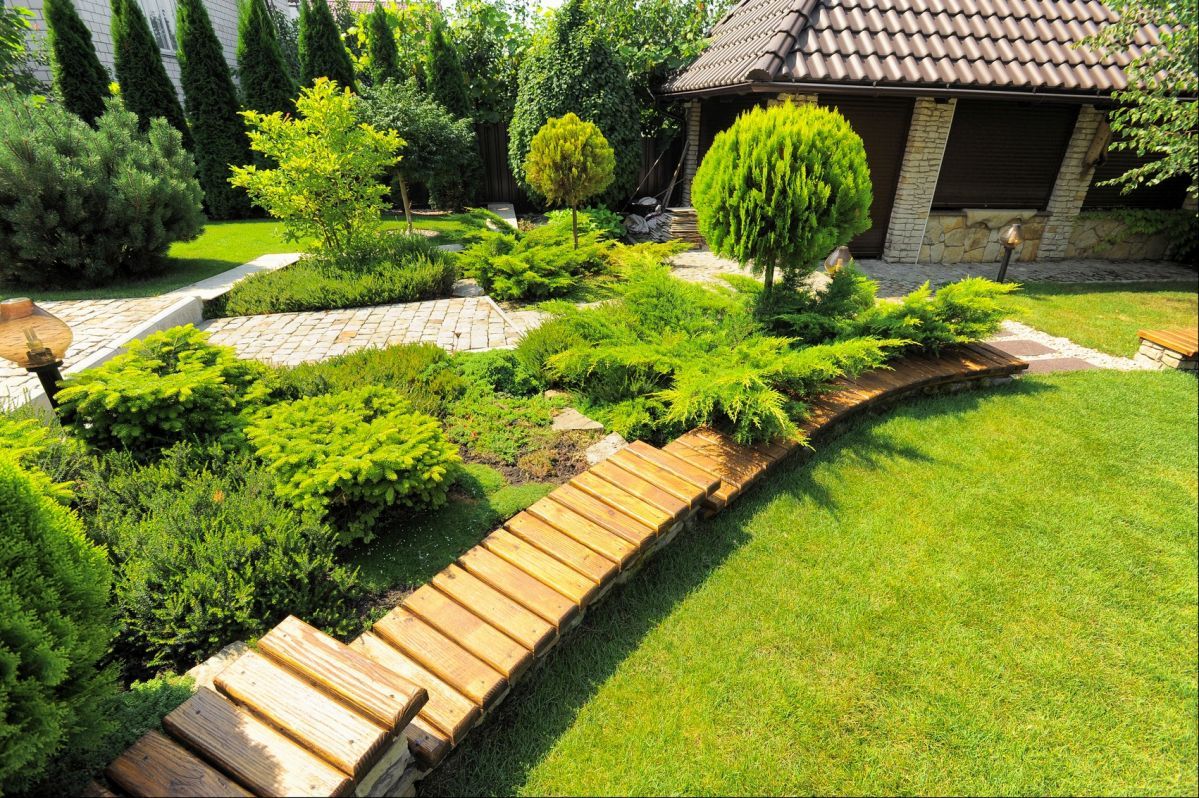
Conifers are universal plants, the abundance of forms and species allows them to be used in landscape compositions different styles (confirmation of this you will find in our photos). At the same time, the size of the plot will not become a problem - if conifers are quite tall in nature, then decorative varieties and species used for landscaping rarely exceed 4 m in height. Design alpine slides it is difficult to imagine without undersized conifers and shrubs (Humpy dwarf pine, Lobers spruce, Mini Pug pine, some types of thuja, coniferous shrubs).

Site design can give the conifer the function of a color delimiter that will resist the merging of natural shades. Thus, conifers will help complicate the color combination of the garden, make it richer and deeper. Often undersized varieties tui with dark needles, they are used as a border for the club, enclosing the flowers inside in a kind of green frame that sets off the bright colors of the flowers. Conifers are always present in the photo of gravel gardens, while cones or medium-sized bark can be replaced in some places.
Mixborder
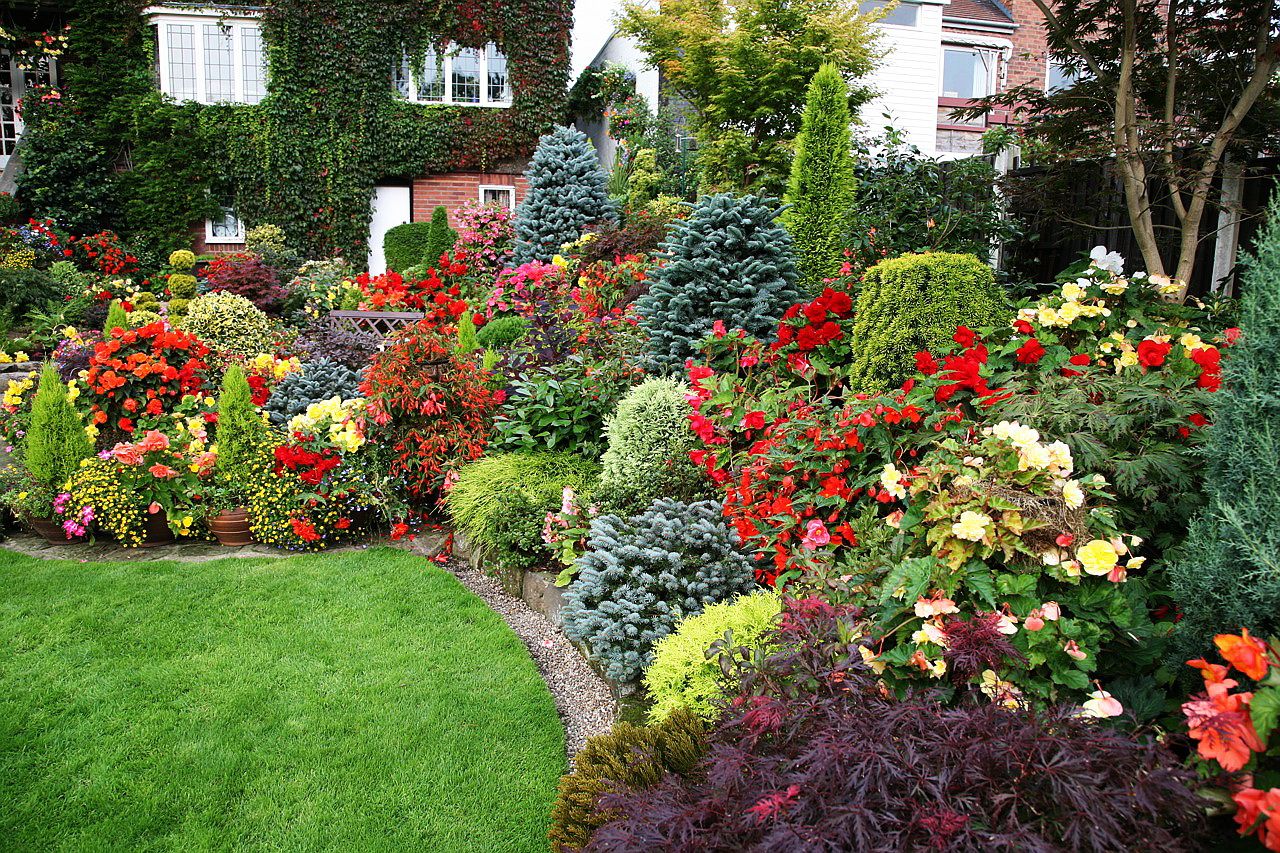
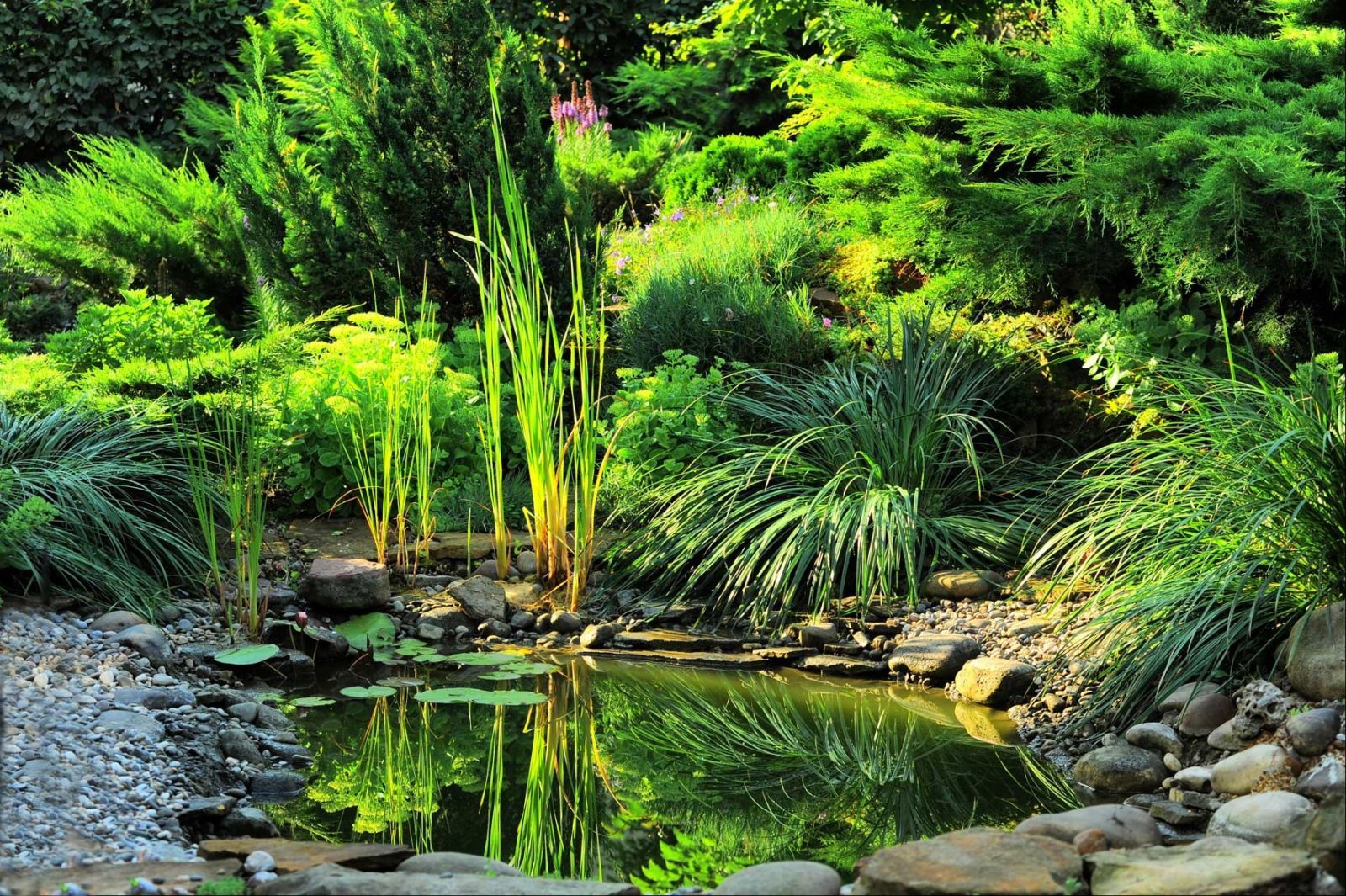
In order for a composition of coniferous plants to look spectacular and harmonious, its design should include the following factors:
- the best background for conifers will be a regular well-groomed lawn

- so that the composition of their conifers (both trees and shrubs) looks harmonious and holistic, a place for best view(location of the gazebo or observation deck) should be located at a distance of not less than 2 lengths of the composition
- the most spectacular in landscape design is the location of coniferous species oriented to the west or east
- geometric shapes - in landscape design it is good to use the principle of contrast, for example, place pyramidal high conifers next to one of the undersized spherical types of thuja. This arrangement of trees of different heights will help to achieve some visual effects - against the background of low-growing mountain pines, several even medium-sized thujas will look very tall

Advice! When placing decorative conifers in the garden, it should be borne in mind that they grow quite intensively in breadth, absorbing the space around them.
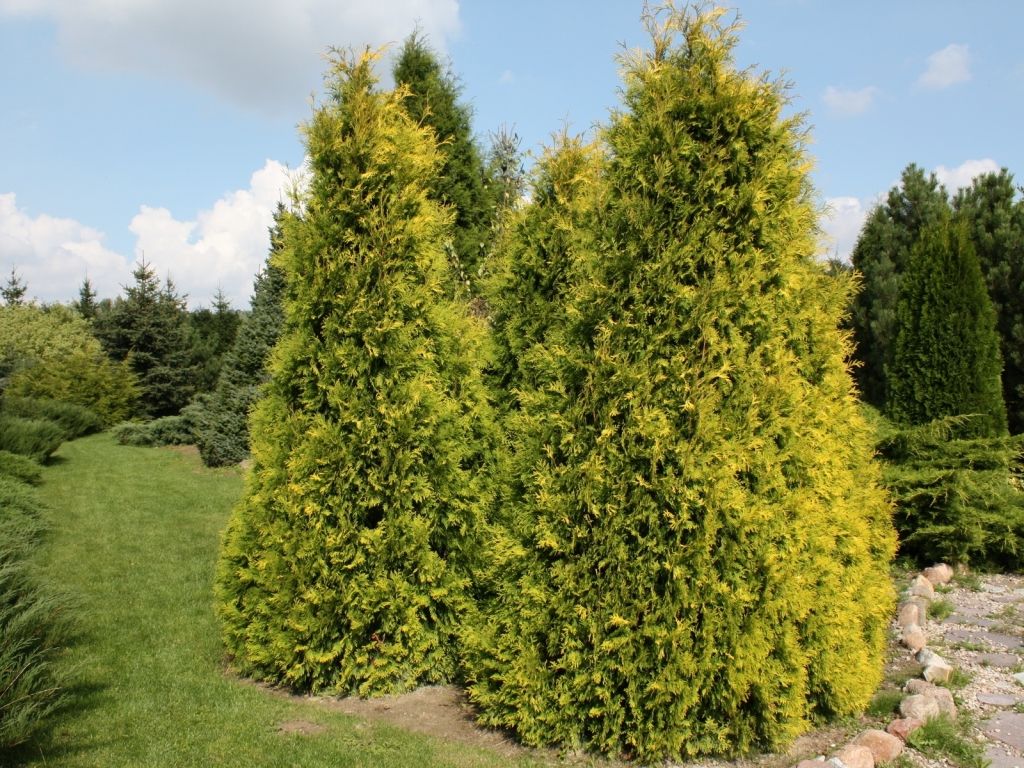
Coniferous trees: design taking into account color compositions
Conifers differ significantly in color - even if we leave aside blue spruces, their needles fill the entire gamut of shades of green in color. Variations of shades (photos emphasize this) allow you to revive the site with their help, creating interesting color schemes. But at the same time, when creating a composition, it is very important to form the correct color scheme:

- for compositions consisting of three components, it is necessary to choose ornamental plants two colors
- in a composition of five elements, three different shades of green can be present
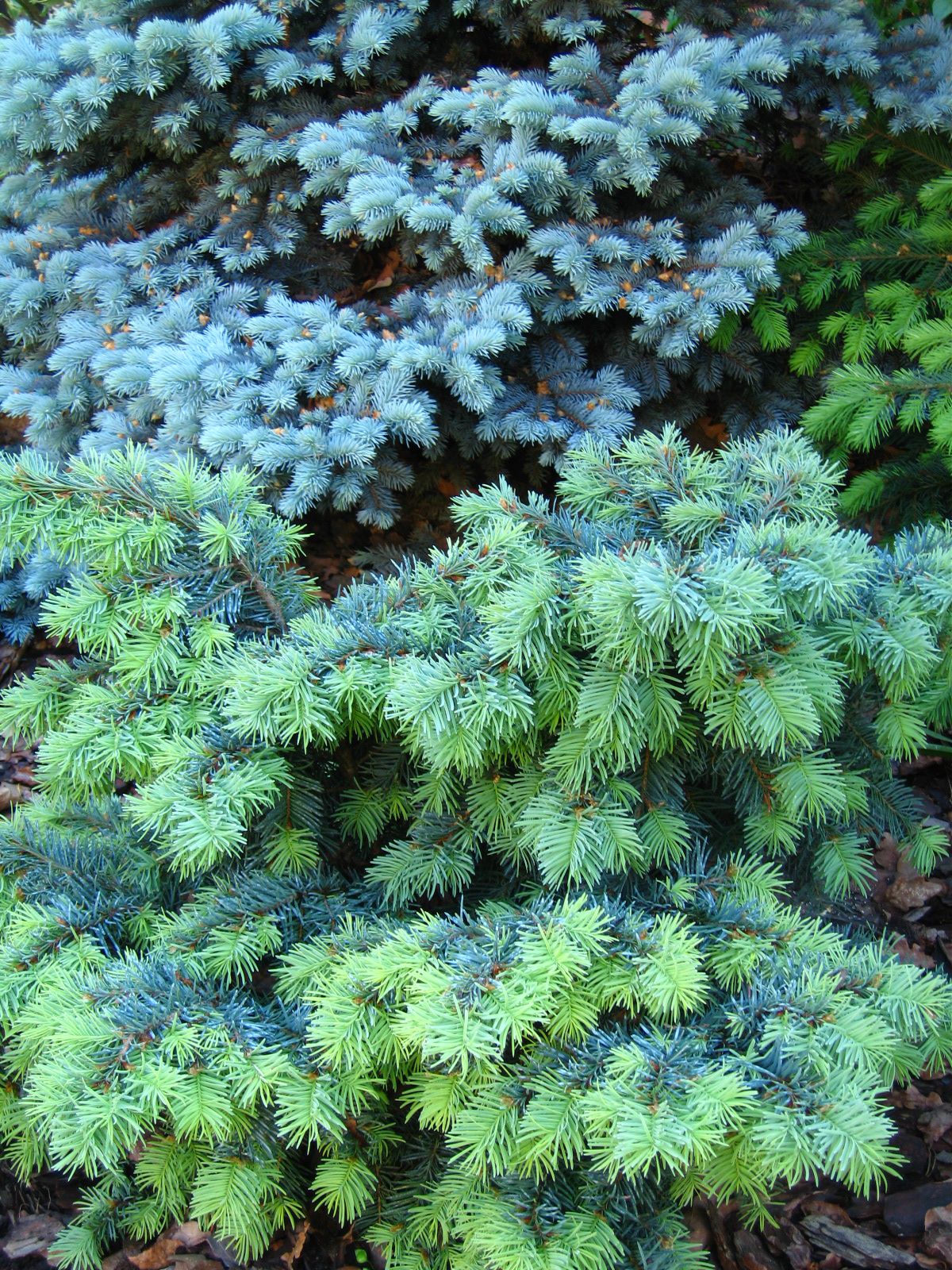
- the design of the "forest in miniature" may include a tiered alternation of light and dark shades of needles - purplish purple. In all types of fir, the cones do not hang down, like in other conifers, but stand on a branch, like candles.
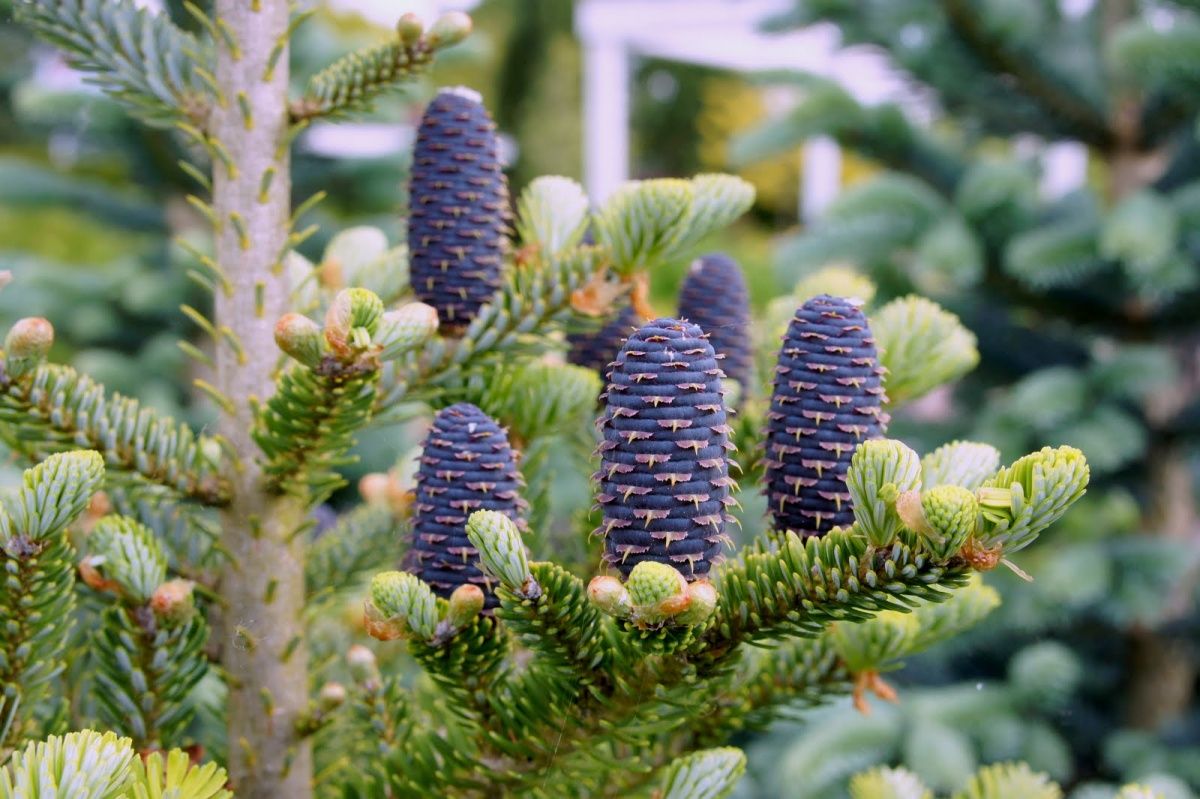
Coniferous varieties with colored needles are, in fact, a very difficult element for a garden. They look very attractive in photos in specialized magazines, but their selection requires skills, otherwise the site design can turn into a lurid blurry abstraction. Consider the example of thuja - it is better to plant them in the fall, it is at this moment that the brightness of the leaves of neighboring plants will help to correctly select and place color accents.
Garden design using coniferous plants, expert advice, names of the best varieties, planting and care rules - see the video for details
Product Catalog
Plants for the garden
The company "GreenMich" provides comprehensive and segmental services in the field of landscape design. Here you will find any plants for the garden, which we offer you to buy in a complex, under the guidance of a specialist who knows absolutely everything about the living material for decorating the site. Today, there is a tendency to install Mauritanian lawns, elegant multi-level flower beds, rock gardens and artificial reservoirs on personal plots, which will require mountain and water green spaces. Our landscaping plant catalog includes ornamental shrubs for hedges, highly selected apples, pears, plums, as well as exotic specimens needed to create a Japanese garden and other conceptual landscapes.
We recommend purchasing decorative plants for the garden according to the draft, strictly following the designer's recommendations. Pay attention to evergreen conifers - they will perfectly decorate the site in winter, when there is no other greenery. The group of conifers, which are very popular today in garden design, has approximately 800 species: spruce and pine, arborvitae and fir, juniper and yew. Plants for landscape design should be diverse - it is very beautiful when some of them literally creep along the ground, others reach 3-4 m in height. Deciduous also differ in size and shape of crowns, foliage and bark color, and horse chestnut, balsamic poplar, bird cherry, mountain ash, linden, viburnum, rhododendron, jasmine also exude a stunning aroma. At the same time, deciduous trees protect the garden from winds and dust, and also enrich the soil with humus.
Catalog of plants - trees and perennial shrubs
Landscaping, plants for which you will find in abundance in our assortment, is, first of all, the aesthetics of a single stylistic integrity. Fruit trees, which fill the garden with abundant fragrant blooms in spring, also bring their own accent. Some varieties - in particular, cherries and mulberries - are extremely decorative and require more care than other deciduous and coniferous varieties.
We offer the best prices for all components of the future landscape, available to almost all of our customers. Before you make a purchase, determine which style of garden suits you best. In a landscape garden, plantings are “allowed” to grow and form flowering ridges that mimic the natural landscape. A regular garden requires symmetry and rigor of lines, imposes restrictions on the number of species. The garden can be "rustic", replete with uncomplicated flowers, combined with the garden due to the original layout of the ridges, it can be designed for outdoor parties or for family vacations. Today, collection gardens and Japanese-style gardens, as well as gardens on a flat exploited roof, are popular.
A living garden, in which one can breathe easily and well, is impossible without trees. If your site has a couple of shrubs, an apple tree and a plum tree, try adding a few conifers and large trees with decorative foliage here - the garden will change. And how to choose the right trees, how to combine and where it is better to place them - read on the website
October 18, 2016
The action looks great on a green background of the lawn, in a mixborder and on an alpine hill (undersized forms). It is combined in compositions with and forsythia in hedges. Swedish botanist K. Thunberg, traveling around Japan in late XVIII century, described this previously unknown shrub and named it after the mayor of Amsterdam, Johann van Deutz. With his assistance, the scientist managed to visit Holland - an exotic country of flowers, which he dreamed of. In total, experts have about 50 types of action, common in East Asia, Himalayas and Mexico.
May 1, 2016
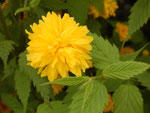 Japanese rose, Easter rose - under such names is known among the people of Kerria. Its bright sunny flowers with a light aroma, decorating the bush in late spring and early summer, and often also in autumn, in September, a compact crown formed by thin flexible erect and slightly drooping at the ends, like flowing branches, will bring a touch of grace and nobility to your garden.
Japanese rose, Easter rose - under such names is known among the people of Kerria. Its bright sunny flowers with a light aroma, decorating the bush in late spring and early summer, and often also in autumn, in September, a compact crown formed by thin flexible erect and slightly drooping at the ends, like flowing branches, will bring a touch of grace and nobility to your garden.
April 30, 2015
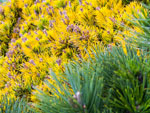 Beautiful in winter and summer! Coniferous plants in summer set off the tenderness of the foliage of trees and shrubs, and in winter they dilute the gray-white landscape with bright green spots. Dear readers, we bring to your attention the second part of the article "Coniferous Island" (). This time we will talk about the "prickly classics" of landscape design: spruce, pine, juniper, thuja. These plants have been known to Russian gardeners and designers for a long time. They are less whimsical than cedar and cypress, and do not require complex care.
Beautiful in winter and summer! Coniferous plants in summer set off the tenderness of the foliage of trees and shrubs, and in winter they dilute the gray-white landscape with bright green spots. Dear readers, we bring to your attention the second part of the article "Coniferous Island" (). This time we will talk about the "prickly classics" of landscape design: spruce, pine, juniper, thuja. These plants have been known to Russian gardeners and designers for a long time. They are less whimsical than cedar and cypress, and do not require complex care.
April 17, 2015
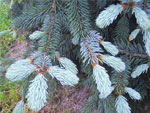 Coniferous plants will be a wonderful decoration for any site. With their help, you can create a unique landscape both in a small cottage and in a park area. They are suitable for decorating flower beds, they will be a beautiful frame for the perimeter of any garden, park and surrounding area. Big variety coniferous shrubs and trees makes it possible to find many options for their use in landscape design, and the variety of varieties and species allows them to be considered the most beautiful species in landscaping.
Coniferous plants will be a wonderful decoration for any site. With their help, you can create a unique landscape both in a small cottage and in a park area. They are suitable for decorating flower beds, they will be a beautiful frame for the perimeter of any garden, park and surrounding area. Big variety coniferous shrubs and trees makes it possible to find many options for their use in landscape design, and the variety of varieties and species allows them to be considered the most beautiful species in landscaping.
All owners of country houses represent the backyard landscaped and immersed in the greenery of trees, shrubs and flower beds. On our planet, there are hundreds of thousands of plants that can be planted on your site. To make the vegetation look attractive in your yard, you should pay attention to landscape design. and shrubs must occur in a certain order. Most often, shrubs, deciduous and coniferous trees are used in landscape design. Still very popular and
The benefits of conifers
Many residents of country houses prefer to use coniferous plants. They can transform the look of any area.
Provide sufficient protection of the personal territory from wind, dust. In addition, they are also characterized by soundproofing properties. The advantage of these plants is that they are able to saturate environment phytoncides. The latter, in turn, are indispensable elements for a person that have a beneficial effect on his state of health.
Many doctors advise planting such plants in the backyard for people who suffer from chronic or frequent diseases of the respiratory system. Conifers have a beneficial effect on immunity and good mood.
Exists a large number of species of coniferous trees and shrubs that can be planted in the garden. These are the well-known spruce, juniper, pine and larch. Of the decorative species, yew, thuja and cypress are used. The last listed types are great for artistic haircuts.

Fast growing conifers
Many people prefer to immediately arrange wonderful compositions in their backyards. For this, plant species that can grow in a short period of time are suitable. Often use fast-growing coniferous trees for landscape design. The most common types are:
- pseudosuga tissolistnaya;
- metasequoia glyptostroboid;
- larch;
- Serbian spruce;
- (elegant).
Features of the location of coniferous trees
Before planting fast-growing coniferous trees for landscape design, a number of points should be considered. Tall trees should not be planted near the windows or walls of the structure. After all, in the period of full bloom, they will prevent the penetration of sunlight. This can lead to the formation and spread of fungi. Coniferous trees are best planted around the perimeter of the plot. The roots of the trees will reliably strengthen the soil, and the shadow from them will not interfere with the growth of other plants on the site.
You can also plant coniferous trees not only along the perimeter of the territory. In landscape design, thujas are often used, which do not cast a large shadow and can be perfectly combined with other plants, flowers and shrubs.
Arrangement of trees
A personal plot cannot be imagined without vegetation. Thanks to the green frame of the house, you can ennoble the most inconspicuous area. The basis of the vegetative design of the backyard territory are trees and shrubs for landscape design. On the site, they can be located in several ways.
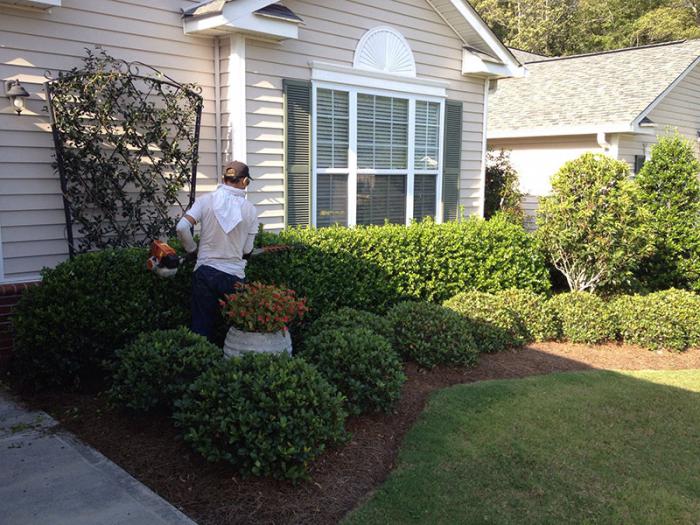
Groups
This method involves the creation of compositions from several plants. It is necessary to select plants taking into account fury. Before tall trees tall shrubs should be planted, in front of which, in turn, it is better to plant low vegetation. So that the composition is not boring, it is better to choose plants with variegated leaves.
In the center of the garden, you can place such a group. In this case, tall plants should be planted in the middle. If the group can only be seen from one side near the facade or fence, make sure that the height of the plants increases towards this structure.
During the planning of the group, the requirements of the plants should also be taken into account. In no case should they obscure each other. In addition, when planting plants, the necessary space should be left between them.
Before purchasing trees for landscape design, you should find out all their parameters: size, crown shape, growth rate and height.
Are you afraid to make a mistake? Then you need to make a dendroplan. Here you can accurately plan the planting of each type of plant. With this plan, you can go to a garden center who will recommend you purchase appropriate plants.

Ordinaries
This way of arranging trees involves using the same vegetation, which attracts special attention. Therefore, such trees should look interesting all the time. In no case should they have flaws. lush shrubs or ornamental trees will look especially attractive. If your territory country house small, then you can get by with planting one large and beautiful tree.
Modern families are trying to start a family tree. Such a plant should grow over several generations, keeping the entire history of the family. The Christmas plant is especially popular. The whole family can dress it up for the New Year and dance around a living tree. If the backyard area is small, then the Christmas tree can be planted in a group of other plants.
alleys
This method of planting vegetation involves the creation of footpaths. In the design of the alleys, a special technique should be observed. Specialists practice mainly close planting of trees. Trees should be planted one after the other at a distance of about 2 meters. Their vaults must be closed. Alleys are best equipped in large areas. For their design, fruit trees are sometimes used in landscape design.

Hedges
This method of placement on the site of plants assumes the presence of a dense linear planting of shrubs. Some gardeners like to form hedges from trees. Such species may require shearing or be free-growing. Such a fence can act as a good protection from the wind and prying eyes. It is hedges that can protect the site and divide it into zones.
Before planning hedge, it is necessary to take into account the height of the future plant. Remember that it is almost impossible to make a hedge out of large vegetation. Also not suitable for creating a green hedge stunted shrubs. You should also pay attention to the shape and size of the foliage. Remember that for hedges it is better to use coniferous trees. In landscape design, they look the best.

Conclusion
The attractiveness of your personal plot directly depends on the chosen vegetation. Remember that trees for landscape design must match the chosen style.



